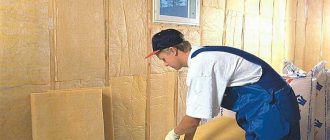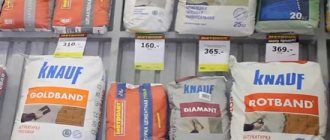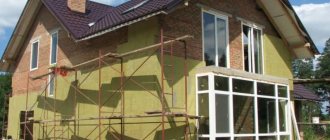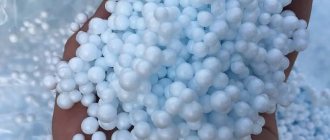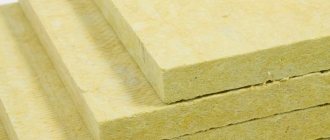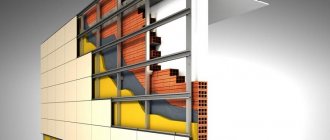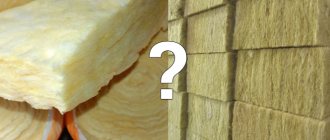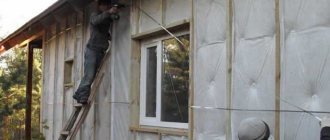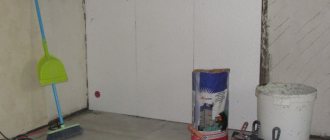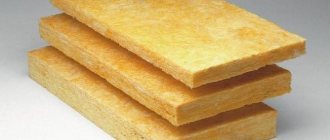Thermal insulation measures are becoming an integral part of construction work. A huge selection of insulating materials and simple installation technology contribute to this. Comfort is created not where they spend a lot of money on heating, but where they retain heat. One of the popular options is mineral wool insulation. The heat insulator has many advantages, and working with it is simple.
general information
Mineral wool is a fibrous material obtained from metal slag or molten rock.
Mineral wool has been used for effective wall insulation for decades, but now manufacturers produce much better products than before. The harmfulness of the material to the environment and the human body has been reduced, and its thermal insulation properties have been increased.
There are several subtypes of mineral wool for wall insulation, and we will now consider them.
Types of mineral wool
Any type of this insulation has fibers. These fibers are formed during the cooling of crushed minerals, which are then pulled into long thin threads. The material is classified based on the initial raw materials:
- Stone. Made from granite, basalt or porphyrite. Insulating walls with basalt mineral wool is best suited for buildings that must be in perfect condition for many decades. This mineral wool has the highest strength.
- Slag. It is based on waste from the metallurgical industry. The quality of this product is lower than that of the previous subspecies. Slag mineral wool for wall insulation does not tolerate sudden temperature changes. Typically used as an inexpensive option for use in sheds or summer buildings.
- Glass. It is made from molten glass, to which limestone, dolomite and soda are added. The most elastic option, well resistant to vibration. Suitable for buildings where fire safety is especially important.
Insulating walls from the inside with any mineral wool requires analysis - which option is suitable in a particular case. Having decided on the type of material, we move on to its form.
Insulation materials
0 votes
+
Vote for!
—
Vote against!
During construction or when carrying out a major renovation, the question arises about insulating a house or apartment, and so that after completion of the work there is no bitter regret about wasted funds, it is necessary to know as much as possible about the materials used. The article will discuss the insulation of walls with mineral wool from the outside and from the inside.
Insulation is an important process in which any deviation from technology is simply unacceptable. Ill-performed work will aggravate the situation. At first it will not be noticeable at all, but much later the accumulation of dampness will lead to the proliferation of a dangerous fungus - black mold.
Recently, thermal insulation work has been gaining momentum, and this is not because the winter months have become harsher, but because it is more economical. Anyone can insulate walls both inside and outside a building, but as for multi-story buildings, the involvement of specialists is required.
What does high-quality wall insulation provide?
- First of all, it is comfort and significant savings on heating. If the walls are protected from the cold correctly, this makes it possible to adjust the desired level of heat in the room. In the summer months, this system operates differently: thermal insulation does not allow the walls to warm up, which means the temperature will be almost constant.
- The lack of thermal insulation can lead to the development of fungi, and as a result the appearance of black mold, which, by the way, is very difficult to get rid of. Inhaled spores are dangerous for a healthy person, not to mention children, the elderly and people with allergies.
- When insulating, the same temperature of the walls and air inside the room will prevent condensation and, accordingly, dampness from occurring. Of course, for greater effect, along with thermal insulation of the walls, it is recommended to change radiators, replace old windows with modern 3-chamber double-glazed windows, and also carry out similar work on the loggia and balcony.
Selecting material for wall insulation
Mineral wool, polyethylene foam, or cork material can be used as insulation. I would like to note that they all cope with their purpose, since they have a low degree of thermal conductivity. Despite all the diversity presented on the building materials market, mineral wool .
Its fibrous structure is obtained by cooling crushed and then drawn into the finest threads (up to 12 microns) of mineral eutectic. Depending on the source raw material, it can be:
- stone. Produced using basalt, porphyrite, granite. This wool is of high quality; it is used for thermal insulation of especially important buildings, where durability is required for many years.
- slag Accordingly, it is made from metallurgical waste. This product is inferior in quality to stone wool. It does not tolerate sudden temperature changes and increased loads, and is not as durable in wet conditions. It is often used for insulating sheds, temporary buildings, and summer houses.
- glass. It is obtained from fused glass with the addition of soda, dolomite and limestone. This product is quite elastic and resistant to vibrations. Recommended for use in structures with increased fire safety requirements.
Mineral wool is produced in rolls or in the form of slabs, where the strength of the fibers is achieved by processing with a special binder material. To create a thermal insulation layer over large areas, mats are used; they allow the work to be completed with minimal disruption.
The degree of rigidity determines its application. The soft type is mainly intended for indoor work using frame structures. Rigid and semi-rigid mineral wool is more suitable for walls exposed to mechanical stress.
Advantages and disadvantages of mineral wool
This non-flammable material, coupled with good heat and sound insulation properties, compares favorably with other insulation materials.
- It does not change shape due to temperature changes, so it is used on objects where the surface temperature can range from -200° to +600°, and in some cases up to 1000°C.
- Cotton wool has biological and chemical resistance and an inert environment, even if metal elements come into contact with it, they do not corrode.
- This heat-insulating product can be easily processed - cut with a knife, sawed with a hacksaw, which greatly facilitates installation work.
- If the finishing layer is made of a material with low vapor permeability, then all condensation will be concentrated in the layers of mineral wool. When wet, its thermal insulation properties are noticeably reduced, and loss of geometric shapes is possible. Therefore, when installing thermal insulation, both facades and interior walls, it should be covered with a membrane film.
- There is a claim that this material has a bad effect on health, releasing hazardous substances. This is not entirely true. When working with it, it is necessary to use gloves and respiratory masks so that the dust generated during cutting does not enter the respiratory tract. In addition, after installation it is covered with a vapor barrier film, drywall and/or other finishing materials.
How to choose mineral wool for wall insulation
The selection of material is carried out according to the following criteria:
- thermal conductivity. This indicator is directly proportional to heat retention directly in the house. Therefore, the smaller it is, the lower the cost of heating the building;
- durability. With proper installation, mineral wool has an almost unlimited service life;
- vapor permeability. A high coefficient of vapor barrier will allow the plaster on the façade, made using the “wet method,” to dry quickly and remove excess moisture in the ventilated structure;
- fire safety. This property is important for a material used for both external and internal work.
- For facades with a frame structure, mineral wool made from rocks or glass is mainly selected. The material must have excellent moisture-resistant characteristics, and the vapor permeability index must be at least 0.5 mg/mhPa.
- If this insulation will carry a load, for example a plaster layer, then special attention is paid to density, so it is recommended to use a material with a density of at least 150 kg/m³ and vapor permeability should be at least 0.35 mg/mh Pa.
- Internal partitions or walls are insulated with both basalt and fiberglass wool. Light wool with a density of 10-90 kg/m³ is suitable here. In addition to thermal conductivity, an important property is noise absorption, so you should choose a product with an index of 42 dB or more.
Technology of wall insulation with mineral wool
It is not always possible to carry out thermal insulation on the outside of a home; this applies more to the owner of an apartment in a multi-storey building. Here the facade is being changed, for which permission must be obtained from the relevant authorities. And, as a rule, the insulation project for one apartment does not undergo approval.
There is a way out of this situation - to carry out similar work from the inside. But opponents of this method argue that such insulation will not lead to the expected effect. And this is not entirely true, if you insulate the walls with mineral wool correctly, in compliance with the technology, then the main goal will be achieved.
Main stages of work:
- Surfaces are thoroughly cleaned, especially if traces of mold are visible. This is done manually with a spatula or a construction vacuum cleaner. For drying, a special hair dryer and infrared heaters are used. If necessary, surfaces are treated with antiseptics;
- all cracks and holes are sealed with cement mixture. For recesses up to 3 cm, polyurethane foam is used, deeper voids are filled with tow and foam;
- treatment is carried out with antiseptic agents and primers. They should be applied with a significant time interval, allowing each layer to dry completely;
- The final stage of preparatory work is being carried out - leveling the surfaces for a tighter connection of the structure or frameless insulation.
detailed instructions
- Brick, gas or foam concrete blocks are plastered and treated with a solution of liquid waterproofing material. After drying, it forms a film that prevents the formation and development of dampness between the wall and the insulation layer.
- The frame is made of wooden slats or metal profiles, taking into account the width of the roll, or more precisely, the distance between the vertical supports should be slightly less than the width of the selected material. This will ensure its tight fit to the structure.
- The distance from the wall is taken by calculating the thickness of the slab plus a few centimeters for the air gap, which is created by an adhesive solution applied in a pointwise manner.
- It is more advisable to use slabs; they do not roll up on vertical surfaces like rolled mineral wool. Here it is recommended to install horizontal strips to reduce the load of their own weight.
- It is recommended to start placing a layer of vapor barrier film from the top of the structure in a horizontal direction. Fixation to the frame can be done with double-sided tape. If it is a wooden structure, then you can use a furniture stapler. The membrane is installed with an overlap of about 10 cm or more and an overlap in the corners, floor and ceiling of the room.
- The joints of the connection are glued with mounting tape or construction tape. It is advisable to seal the places where the film is adjacent to the surfaces with a liquid sealant. A counter-lattice is attached to the top of the peculiar “pie” with slats 15-25 mm wide. This is done so that a ventilation gap is formed between the vapor barrier layer and the inner lining. Here you can install the selected finishing material: drywall, panels, lining, and so on.
- But the vapor barrier material can not be used if you purchase foil-coated mineral wool. In this case, the side with the foil should “look” into the room. This coating provides this material with additional heat-saving properties.
- If preference was given to roll material, then the work is carried out in a slightly different way. U-shaped brackets are fixed to the surfaces for installing metal profiles. As a rule, the vertical distance between them is 60 cm, and the horizontal step is 50-60 cm. These parameters are quite sufficient for laying insulation.
- Next, you should measure the mineral wool of the required length, making sure to leave a tolerance of about 10 cm. The properties of the material allow it to pass freely under the bent “ears” of the staples. They will securely fix the insulation in a vertical position. Then the profiles are installed and the plasterboard sheets are mounted.
Insulating walls with mineral wool video
Insulation of external walls with mineral wool
Experts recommend insulating the outside of the building. This is the most productive option to retain heat in the premises; moreover, useful centimeters of space are not taken away and condensation does not form. In addition, an additional layer of thermal insulation will help avoid cold bridges that inevitably form due to the sheathing under the insulation.
There are two most popular methods.
Wet method
- Its principle is to install insulating material directly on the wall, on top of which finishing work is carried out. Thus, a homogeneous, seamless coating is obtained. In this case, the thickness of the insulation should be about 15 cm.
- The mineral wool is fixed to the surface with an adhesive composition; the main fasteners are hardware - “umbrellas”. Next, the finished base is reinforced. The final stage consists of façade finishing, for example, with decorative plaster, which will perform a protective function and give an attractive appearance to the building.
- This method is ideal for houses built of brick, gas-foam concrete blocks. For frame buildings, a rigid flooring made of OSB boards is first installed under mineral wool. It is strictly forbidden to carry out work during rain; if the insulation gets wet, you will have to wait a very long time for it to dry.
Dry method
- By performing thermal insulation work on a building in this way, the result is a ventilated façade. The material is mounted in cells or honeycombs formed by the frame structure. If timber is used to make the frame, it should be coated with an antiseptic.
Advice: when making the lathing to fix the insulation, it is most convenient to leave the distance between the horizontal slats narrower, along the width of the insulation. But you can save a lot of money if you do them less often, in increments equal to the length of the mineral wool slab.
- A moisture-proof film must be laid on top of the insulation, which can be secured with double-sided tape or a construction stapler.
- Then slats are attached to the main frame, forming a sheathing. Here it performs 2 functions: it creates an air cushion and serves as the basis for installing cladding, such as siding or asbestos-cement slabs.
To achieve the goal, work related to insulation must be carried out on both internal and external surfaces. A kind of “pie” consists of the following layers (from the inside to the outside):
- finishing materials: putty, wallpaper, painting;
- plasterboard sheets;
- vapor barrier membrane;
- mineral wool;
- main wall;
- mineral wool;
- moisture-proof material;
- finishing material: siding, lining and so on.
Compliance with the basic requirements during construction will help protect the house from moisture, wind and, accordingly, dampness, thereby creating comfortable living conditions.
Manufacturers of mineral wool
- Today, many manufacturers offer this thermal insulation material to the consumer. The most famous are: “Isover”, “Knauf”, “URSA” and “Rockwool”. These brands always provide certificates for their products, hygienic assessment of the product, test reports, and so on.
- Some companies specialize in the production of a certain type of wool, for example, Ursa produces mostly fiberglass-based wool. But still, large factories produce products of all types.
- Marking will help you understand for what structures or climatic conditions this or that mineral wool is intended. But, unfortunately, each manufacturer has its own, and the question of uniform indicators has already been raised.
- If the packaging indicates the thermal conductivity, dimensions, purpose of the material, and if it is also accompanied by a package of relevant documents, then this guarantees that the purchased product is of high quality and reliable. Such mineral wool will last a long time without losing its thermal and acoustic characteristics.
- After all, if you choose the wrong material, you may not get the expected result; on the contrary, it will significantly reduce the energy-saving properties and may well destroy the structure. Ultimately, additional costs for correcting errors cannot be avoided.
Sizes and shape of mineral wool
Stone wool for wall insulation, like any other, is produced in two formats - roll and slab.
Rolled wool consists of long strips of material. The length is from 7 to 10 meters, and the width is a maximum of 120 cm. Thickness is 0.5 cm. These parameters make it easy to transport mineral wool and attach it to the wall. Cotton wool in rolls is usually sold of lower quality and, accordingly, at a lower cost.
Insulating walls with stone mineral wool in the form of slabs is even easier. The slabs are designed specifically for smooth vertical surfaces. Typically, the size of each unit is 120 cm in length and 100 cm in width. Thickness from 3 cm (for floors) to 10 cm (for roofs). Laying such slabs is very easy; you don’t have to hire a professional for this.
Advantages and disadvantages
The advantages of insulating walls with mineral wool include the following factors:
- the material absorbs sounds well;
- low flammability;
- metal products do not rust when in contact with insulation;
- thermal stability, no deformation even with temperature fluctuations;
- easy processing (cutting, sawing).
There are also disadvantages:
- low vapor permeability, due to which condensation often appears - it is recommended to attach a membrane film as the top layer;
- There is still a stereotype that the substances released by mineral wool are harmful to health, but if you buy high-quality material, you don’t have to worry about this.
To choose the right mineral insulation for thermal insulation of walls, pay attention to thermal conductivity, vapor permeability and flammability. Much depends on the purpose: glass or stone wool is suitable for facades.
What mineral wool should I use to insulate walls under plaster? The densest - no less than 150 kg/cub.m.
To insulate walls and partitions inside a home, mineral wool with a density of 10 to 90 will be sufficient.
Price list
Popular turnkey projects
| Name / Thermal insulation thickness | 50mm | 100mm | 150mm |
| Turnkey ventilated facade, rub/m2 | 3330 | 3440 | 3550 |
| Wet facade “turnkey”, rub/m2 | 2340 | 2560 | 2780 |
| Name / thickness of thermal insulation | 60mm | 80mm | 100mm |
| Turnkey installation of thermal panels lined with artificial stone, rub/m2 | 3300 | 3450 | 3550 |
| Name | Price |
| Processing the seams of a panel house using warm seam technology | 300 r/m. |
Ventilated façade
| Name | Price |
| Thermal calculation | For free |
| Pull-out testing of anchors | For free |
| Geodetic survey of the facade | 20 rub/m2 |
| Design work | 70 rub/m2 |
| Installation/dismantling of frame scaffolding | 120 rub/m2 |
| Marking walls for brackets | 50 rub/m2 |
| Installation of brackets | 150 rub/m2 |
| Attaching extension cords | 100 rub/m2 |
| Installation of the first layer | 200 rub/m2 |
| Installation of the second layer | 100 rub/m2 |
| Installation of guides | 200 rub/m2 |
| Fastening the facing layer | 600 rub/m2 |
| Construction of a subsystem for a parapet cover | 500 rub/m2 |
| Installation of parapet ebb, m. | 400 r/m. |
| Installation of ebbs, slopes, drips, linear m. | 350 r/m. |
Cladding with thermal panels
| Name | Price |
| Thermal calculation | For free |
| Leveling plaster (with a difference of more than 30 mm) | 520 rub/m2 |
| Frame structure (with a difference of more than 30 mm) | 300 rub/m2 |
| Fastening thermal panels | 800 rub/m2 |
| Grouting joints | 300 rub/m2 |
| Construction of slopes, running meters: | |
| Plastering | 650 r/m. |
| Steel | 350 r/m. |
| From clinker tiles | 800 r/m. |
| Installation of ebb tides | 350 r/m. |
| Installation of spotlights | 600 r/m. |
| Attaching the end strip | 350 r/m. |
| Installation of a drainage system | 350 r/m. |
Masonry
| Name | Price |
| Rough masonry of partitions (thickness up to 200 mm for blocks and 120 mm for bricks) from: | |
| Foam blocks | 400 rub/m2 |
| Gas silicate blocks | 400 rub/m2 |
| Expanded clay blocks | 400 rub/m2 |
| Brick | 450 rub/m2 |
| Rough masonry walls (thickness more than 200 mm for blocks and 120 mm for bricks) from, m3: | |
| Foam blocks | 2600 rub/m3 |
| Gas silicate blocks | 2600 rub/m3 |
| Expanded clay blocks | 2600 rub/m3 |
| Brick | 2800 rub/m3 |
| Fastening thermal insulation with disc dowels | 200 rub/m3 |
| Facing brick walls half a brick thick | 800 rub/m3 |
Necessary tools and materials for work
There are several ways to insulate walls, which we will consider below. But there is a certain set of materials and tools that will be useful in almost any case:
- roulette;
- building level;
- screwdriver;
- self-tapping screws, screws, nails;
- metallized tape;
- waterproofing membrane;
- wooden slats;
- dowels;
- knives;
- primer;
- and, of course, the mineral wool itself.
Instead of wooden slats, it is permissible to use metal profiles. In addition, do not forget to protect your health: prepare a respirator, gloves, special glasses or a full-fledged protective suit.
Technology and methods of wall insulation
Having chosen the desired thickness and other properties of mineral wool for wall insulation, it’s time to move on to choosing a fastening method. When it comes to exterior work, there are three main methods to do this: the well system, the wet method and the ventilated façade.
The first point implies the following design: mineral wool is laid between bricks (or other building materials) inside the wall. A ventilated facade is an option for wooden houses, when a frame is erected around the perimeter of the building, and mineral wool is tightly laid inside it. Attaching mineral wool to the wall is easy; it requires either plastic dowels or an adhesive.
As for the wet method, the slabs should be fixed directly on the surface of the wall, and not inside it. Let's consider this option in more detail.
Video description
Video instructions for external installation of mineral wool under plaster:
- If the wall does not allow air to pass through (for example, made of brick), steam should not pass either into the wall or from the wall into the room.
Otherwise, there is a high probability of moisture accumulation in the wall material and the thermal insulation layer. In this case, the development of all the accompanying negative processes is inevitable - freezing of the walls, the formation of fungi and mold.
Dew point
The most important factor in the proper arrangement of a thermal insulation layer is taking into account the dew point. If its position is inside the wall, this means that moisture will begin to accumulate inside it and destroy the material. Thermal insulation shifts its location in two ways:
- Outside – when laid externally they are a little warm.
- Inside – with internal insulation.
External wall insulation
The procedure for the wet method is as follows:
- Clean the surface, get rid of all depressions and irregularities.
- Secure the basement cornice.
- Glue mineral wool with a special compound.
- For additional security, secure it with dowels.
- Apply reinforcing mesh.
- Prime the surface thoroughly.
- Plaster it.
- Finally, paint it any color you like.
If this option is not suitable and you are inclined to classic insulation, then build a ventilated facade according to our instructions:
- Saturate the wall with an antiseptic composition. If you notice rot, it also needs to be treated with a special solution.
- Remove slopes and/or trims.
- Dry the walls for at least 24 hours.
- Lay a layer of membrane with high vapor permeability so that the smooth side is in contact with the mineral wool. The membrane does not need to be used if the wall is perfectly flat.
- Using self-tapping screws, secure the wooden slats to the wall; their thickness should be equal to the thickness of the insulation, and the distance between them should be 2 cm less than the width of the mineral wool slab.
- Place the insulation material into the resulting sheathing.
- The next layer is material for protection from wind and water. You can attach it with a stapler.
- To form a ventilated gap, counter battens are also nailed on top of the sheathing - the facing material should be at a distance of 6 cm from the insulation.
At the end, install new platbands and slopes (the old ones will not fit because the thickness of the walls has increased).
In what cases is it better to use mineral wool?
It is difficult to answer the question of what is better to insulate a house, mineral wool or polystyrene foam. After all, various factors are taken into account. For example, polystyrene foam is not suitable for wooden houses, since it is not vapor permeable. But, protection from moisture is better. On the other hand, it burns, is not environmentally friendly and is spoiled by rodents. Although, mineral wool weighs more and is more expensive. Such nuances are taken into account and the best option is selected.
Insulation of the walls of a wooden house from the inside is done with cotton wool, since polystyrene foam releases harmful substances when heated. In conditions of elevated temperatures, cotton wool is also better suited (sauna, bathhouse, wall near the fireplace or near the stove). The same applies to insulation in a house where an allergy sufferer lives. It is also better to insulate the roof and ceilings with cotton wool.
Calculate the insulation of your home
The required amount of mineral wool is not selected at random, but taking into account the weather conditions of a particular region.
In the Moscow and Leningrad regions, for example, the climate is temperate and continental. Here it is recommended to insulate the house with mineral wool slabs with a thickness of 8 to 10 cm. The further north you are from these places, the greater this figure will be. In the Murmansk region, the optimal thickness of wool for wall insulation will be about 15 cm.
A material whose density is less than 40 kg/cubic meter is used exclusively on horizontal surfaces that are not subject to load (this is the kind of mineral wool that is usually produced in the form of rolls).
For insulation of external walls, the density is in the range of 50–75, and for creating a ventilated facade - all 110, and even more if the surface is still covered with plaster.
